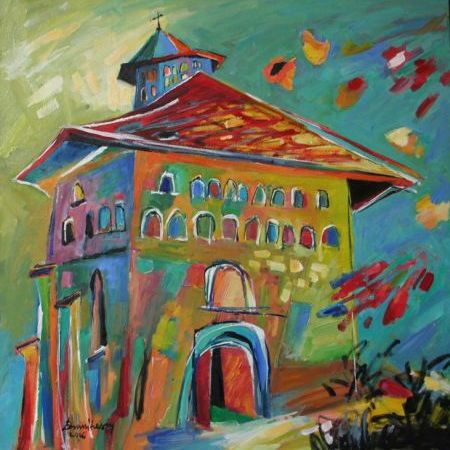The origins of this beautiful monastery aren't precisely known, but the first documentary sources tell us that a first stone church was built in 1402 - 1410, during the reign of Alexandru cel Bun. It was then that the very first monastic complex was built here, and was already considered to be a major religious and cultural centre, although little is known about it's actual appearance. The monastery was later helped and protected by Stefan cel Mare, who gave several villages and lands to the church, which made it one of the richest in the land.

Marinella Dumitrescu - Manastirea Moldovita
Marinella Dumitrescu's Art Gallery
This very first complex was destroyed by the end of the 15th century, probably due to a major landslide, and the ruins cand still be seen today, not far from the new monastery. This new place of worship was built in 1532 by Petru Rares, who hurried the rise of this church and slowly reconstructed the monastery complex around it. This time the monastery had high and strong defence walls, which gave it the look of a fortress. Over the following decades and centuries this evolved into a major culture center, and it was here that religious texts were copied and the manuscripts enriched with paintings and various scenes. The oldest such manuscripts date from the 15th century and are unique works of art, of great value for all, as they show how important the manuscripts were for the Church at that time. In the following centuries this place would also become known as a school for copists and miniaturists, of great quality, literally a worthy rival to the European schools.
The church of the Moldovita Monastery keeps the traditional style and shape, with some innovations which were introduced during the times of Petru Rares, with large arcades, some gothic elements - including a portal - interesting and well kept interior and exterior frescoes, several items and elements on the inside. Among the paintings featured inside you can see an impressive Crucifixion, a Last Supper, the carvings of the altar, a touching image of the Holy Virgin. The Italian influence is easily recognisable, although the names and stories of the painters have long been lost. The outside frescoes were finished in 1537 and bears a shocking similarity to that at the Humor Monastery. You can also see a surprising large scale composition depicting the Siege of Constantinoples and several other religious scenes, portraits of saints and even portraits of ancient philosophers, all in great detail and surprisingly strong and intense colours, very well preserved. A beautiful museum of Middle Age religious art. Also surprising is the realism with which these works were made, which shows the painters were not only trained in Europe - most probably France - but also in touch with the trends and techniques in fashion at that time.
There is also an impressive museum at the monastery, dedicated especially to religious manuscripts of tremendous value, dating as early as the 15th century, and also several documents about the history of the place, with the rules, events and important figures that had chosed the life inside this walls.
In 1785 the monastery was closed and was reopened only in 1932, when it was a monastery for nuns, only to be restored and reconstructed in the 1950s - 1960s, from the ground up. Nowadays it still is one of the most important monasteries of Romania, one of the oldest, and surely one of the most beloved.
September 2008

































